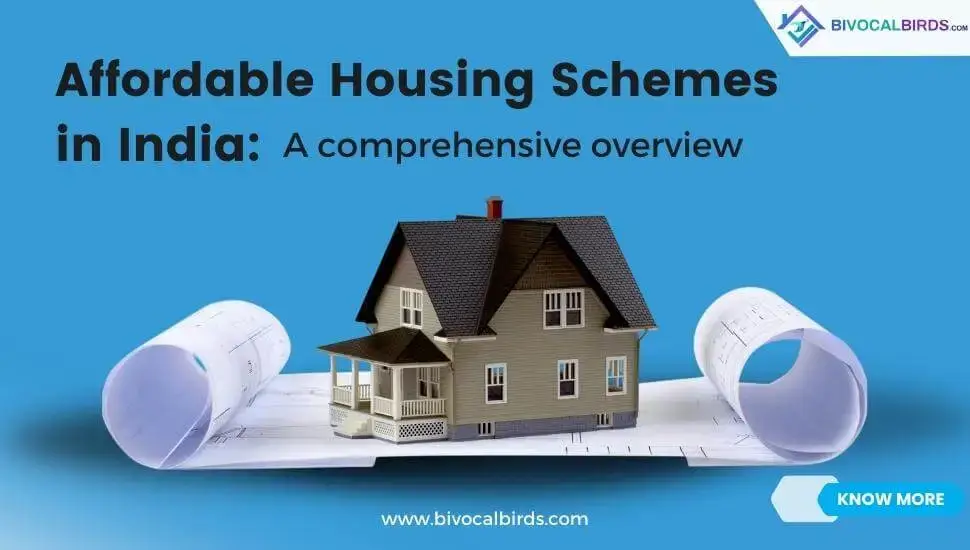Affordable Housing Schemes in India: A comprehensive overview
 03-Nov-2023
03-Nov-2023India faces a massive housing shortage, especially for low and middle-income groups. The demand for affordable housing has increased rapidly over the years due to rising populations and urbanization. The central and state governments have introduced various affordable housing schemes to address this need. These policies aim to provide subsidies and make buying or constructing a house more accessible for economically weaker sections of society.
This blog will explore some of India's significant affordablehousing schemes, benefits, eligibility criteria, and critical features.
Pradhan Mantri Awas Yojana (Urban)
The Pradhan Mantri Awas Yojana (Urban) or PMAY is the flagship affordable housing scheme launched by the Modi government in 2015. It aims to build over two crore affordable houses nationwide by 2022.
The scheme is implemented through four verticals:
- In-situ Rehabilitation - For slum dwellers
- Affordable Housing in Partnership - With Private Developers
- Credit Linked Subsidy Scheme - Interest subsidies on home loans
- Beneficiary-led Construction - Financial assistance to individuals
Based on income levels, the scheme categorizes beneficiaries into three groups - Economically Weaker Section (EWS), Low Income Group (LIG), and Middle Income Group (MIG).
Also Read - PM SVAMITVA Yojana: Benefits and Challenges for Property Owners
The scheme provides several benefits, such as:
- Interest subsidy of 6.5% on housing loans up to Rs 6 lakhs for EWS/LIG groups
- Subsidy of 4% and 3% on loans up to Rs 9 lakhs and Rs 12 lakhs for MIG groups
- The increased carpet area of houses - up to 30 sq. mts for EWS, 60 sq. mts for LIG, and 200 sq.mts for MIG
- Women beneficiaries get an additional interest rebate of 0.5%
The eligibility criteria under PMAY include:
- Family income should be below Rs 3 lakhs for EWS, Rs 3-6 lakhs for LIG, and Rs 6-18 lakhs for MIG
- Applicant should not own a pucca house
- Preference to women, SC/STs, and disabled persons
Pradhan Mantri Gramin Awas Yojana
The Pradhan Mantri Gramin Awas Yojana, or PMGAY, is the rural housing scheme under PMAY. Launched in 2016, PMGAY aims to provide pucca houses with basic amenities to all homeless households and those living in dilapidated houses in rural India by 2022.
Key features of the scheme include:
- Financial assistance of Rs 1.2 lakhs in plains and Rs 1.3 lakhs in hilly states
- Unit assistance of Rs 1.5 lakhs to SCs/STs
- The house should have basic facilities like LPG connection, electricity, toilets etc.
- Convergence with other schemes for building houses
PMGAY Eligibility Criteria:
- The beneficiary should be from EWS/LIG backgrounds with a housing shortage
- Women, disabled persons, minorities, SC/STs, and freed bonded labourers get priority
- Should not have availed central housing assistance earlier
Rajiv Awas Yojana
The Rajiv Awas Yojana (RAY) is another major affordable housing scheme launched in 2009. RAY aims to make India slum-free by providing affordable housing and improving slum conditions.
Key objectives include:
- Slum rehabilitation and redevelopment
- Creation of affordable housing stock
- Tenure security for slum dwellers
- Community participation in project planning
Under RAY, the central government provides financial assistance of Rs 1 lakh per house. RAY prioritises SC/STs, minorities, cities with high slum populations and cities of heritage value.
Also Read - Some useful tips on how to reduce home loan EMIs
The target beneficiaries include:
- Slum dwellers and squatters
- Economically weaker sections
- Low-income groups
- Scheduled castes/tribes
- Vulnerable groups like women and disabled
State Government Schemes
Apart from national schemes, state governments have also introduced housing schemes to promote affordable housing. Some popular state schemes include:
- JNNURM and RAY schemes in Maharashtra
- MHADA lottery system for low-cost flats in Mumbai
- Tamil Nadu Slum Clearance Board scheme
- Karnataka Housing Board schemes
- BEST Housing Schemes in Mumbai
- JNNURM Basic Services to Urban Poor in Andhra Pradesh
- Madhya Pradesh Housing Board schemes
- Odisha Landless Slum Dwellers Housing Scheme
These state schemes provide affordable flats, houses, and plots through lottery systems, subsidies, partnerships, and rehabilitation of slums.
Also Read - The Noida Master Plan 2031: An Analysis and its Implications for the Future
Bottom line
The affordable housing schemes by the Indian government aim to achieve the vision of ‘Housing for All’ and promote inclusive development. These schemes have made housing more affordable for the urban and rural poor by providing subsidies, incentives and financial assistance.
While considerable progress has been made, more efforts are needed to improve awareness, tackle implementation bottlenecks and expand the availability of low-cost housing across the country. Robust policies, public-private partnerships and greater community participation can go a long way in enabling millions of underprivileged Indians to realize the dream of owning a pucca home.
For further information, You Can Call us or Email us at support@bivocalbirds.com.
Related Blogs:
- Everything you need to know about Noida master plan 2031
- Navigating NaMo Bharat: A Comprehensive Guide to Delhi Meerut RRTS RapidX
Best Location To Live In:
- 6th Avenue Greater Noida
- amrapali zodiac sector 120 noida



